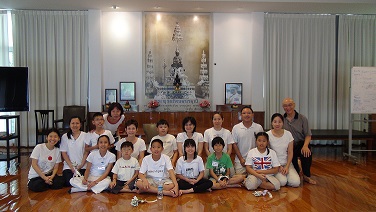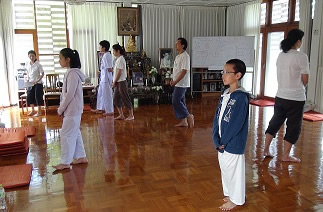Vipassana meditation program Phase 1 - 2007 to 2012
The flagship Vipassana meditation program Phase 1 was initially to support the Vipassana Meditation program at Wat Tamaoh Meditation center in Lampang Thailand in the tradition of mindfulness meditation.
It was hoped that the center will foster future teachers who can support the same kind of mindfulness meditation. The program expanded from facilitating meditators with experience to introductory courses and to cover young children in family orientated courses.
The success of the courses lies in the use of Constructionist techniques to promote individualized learning.
The hindrance of happiness is strong desires. Man’s happiness does not depend upon ‘how much we have’ but ‘when we have enough’. Happiness does not depend upon what we possess and what we get.
Therefore the first step to happiness is ‘to know to stop and to be satisfied.’ If we do not know how to end our desires, we will run and chase ‘our desires’ causing weariness and dukkha (suffering) will follow.
Vipassana meditation program Phase 2 (from 2013) is given in the following Link.
For Vipassana meditation, one week would be considered “short” and one month is not uncommon. Looking at alternatives to the usual seven-day course, we began to distinguish among the interests and needs of different demographic groups.
We found that there were many people looking for a short course either to get an introduction to Vipassana meditation or a primer to clarify various aspects of Vipassana meditation practice.
For both these
groups, the short three-day meditation course prepares meditators before they
proceed to the longer and more intensive seven day or longer meditation
retreats at Wat Tamaoh.
EPWF is also providing 3 or 4 hour meditation sessions to generate interest and a stepping stone to attend the 3 day courses.
Vipassana mindfulness for daily life
In addition to helping advance meditation practice at Wat Tamoah or any conducive meditation center, the short courses give strong emphasis to practical techniques to use the Vipassana mindfulness techniques in his or her practice for ordinary daily life.


Courses for young people and children
Through the short courses, we also discovered a demand for instruction in meditation from parents for a younger generation of university students and children of high school and even primary school ages.
We have found that children as young as seven years can participate successfully in these introductory courses. The language and vocabulary are adapted for children. Practice periods start at 5 minuits and gradually extend to 40 minutes.
Courses for families
The demand from school children has developed into meditation courses for families who attend the courses as a family unit. There are separate sessions for parents and children along with joint sessions.
The idea is that the practice continues in a dhamma family when they return home supported by a network of dhamma families. Mindfulness and meditation practice are integrated into daily living and continued in the family, school, and social context. Refresher courses are offered every six to twelve months.

meditators. Children are taught the same
mediation techniques as adults.

Constructionism and meditation
Traditionally, constructionism involves a process of taking our internal thoughts and making an external physical representation , e.g. on paper or a physical
model, etc. And subsequently the external physical object helps the mind
learn internally. This repeated cycle of externalization and internalization is the keystone of constructionism.
Constructionism
fits well with meditation practice. Vipassana mediation is essentially about
"observing how we feel" about our body and our mind (or feeling in the heart).
Replace "internal thought" in the description of the constructionist method
above with "internal observing how we feel" and we have the description of how
constructionism can facilitate Vipassana meditation practice.
The facilitators use physical bodily movements, diagrams and illustrations to
explain the feeling of various familiar physical phenomena of the body; the
physical movement is physical, but the feeling of the movement is a
mental phenomenon. Later, pure mental phenomena such as like and dislike, anger, impatience, etc. are explored. All learning is through
true individual experiential feeling and not through thinking or analysis.
How the mind works is illustrated by mind-maps, diagrams and
graphs which can be shared.
Another constructionist aspect of the course for families is that parents and children become
facilitators not only for their peer groups but also between groups. In
constructionism, children can facilitate their parents just as parents facilitate
their children, thereby nurturing the development of meditation facilitators in all age groups.
Other techniques employed include breaking the instructions down into small, simple pieces that can be easily and quickly learned. Throughout, the facilitator gives close attention to feedback from the learners, either individually or in small groups. Both learners and facilitators learn to develop patience, persistence and perseverance.
In one sense, meditation is not too difficult. The challenge for most people is repeating the same simple exercises over and over again.
S & P: Strong Body, Pure Mind
We now recognize that there is a need to advise on good health practices for meditators, without which it is not possible to undertake the rigorous demands of intensive meditation practice. Starting in 2013, the meditation programs for various age groups and different backgrounds have been brought under the "Strong Body Pure Mind program" - "S & P" for short, which incidentally also recognizes the hosts for the location of these programs at Baan Raiwa of the S & P group at Bangphra, Cholburi.
Exercise with mindfulness in S & P program

Another feature for the S & P program is the coupling of life planning with mindfulness meditation practice to implement the following Buddhist concept:
The hindrance of happiness is strong desires. Man’s happiness does not depend upon ‘how much we have’ but ‘when we have enough’. Happiness does not depend upon what we possess and what we get. Therefore the first step to happiness is ‘to know to stop and to be satisfied.’ If we do not know how to end our desires, we will run and chase ‘our desires’causing weariness and dukkha (suffering) will follow.
This concept is of great importance in the age of the Internet, globalization and international consumerism, which have led to a loss of identity and an uncertain moral compass for all age groups, but particularly for the younger generation.
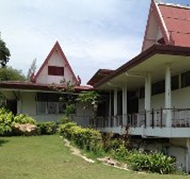
Bangphra, Cholburi. This is the main
venue for EPWF's vipassana meditation
program
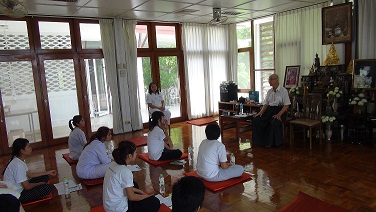
The way ahead...
Looking ahead, we shall continue to innovate - not in new practices which are well founded in the two great traditions of Samatha and Vipassana Meditation - but in the way they can be used separately in tandem, recognizing their different natures and potential. Just as oil and vinegar are mixed for optimal taste, the two meditation traditions work together in order to be responsive to the different needs of different meditators at differing levels of competency. We shall seek to integrate mindfulness meditation practice in a practical way to be suitable for the ever changing demands of daily life.
It is hoped that from these different groups, facilitators will emerge and thus expand this program - the development of facilitators being one of the key objectives of the program. At present there are only three part time facilitators including Mr. Bangkok Chowkwanyun.
At the end of 2012, EPWF had contributed Baht 1.5 million to introductory meditation courses, the development of meditation teachers, and the S & P program.
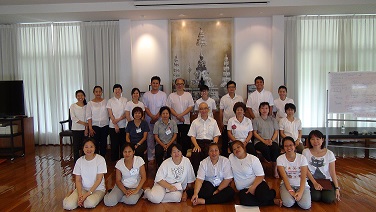
|
|
|
Facebook and meditation
Related to the future, we may note that the EPWF Vipassana Meditation program has grown and developed with very little formal publicity or promotion by the Foundation. Awareness of the program among participants has come about primarily by word of mouth and from its Facebook page (which is, however, moderated by an EPWF meditation facilitator). This makes us optimistic that social networking may be a cost-effective way to develop further - to leverage - not only the meditation program but also the water and village development projects presented in the previous section.

